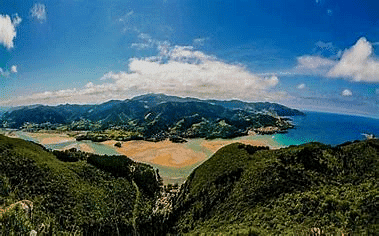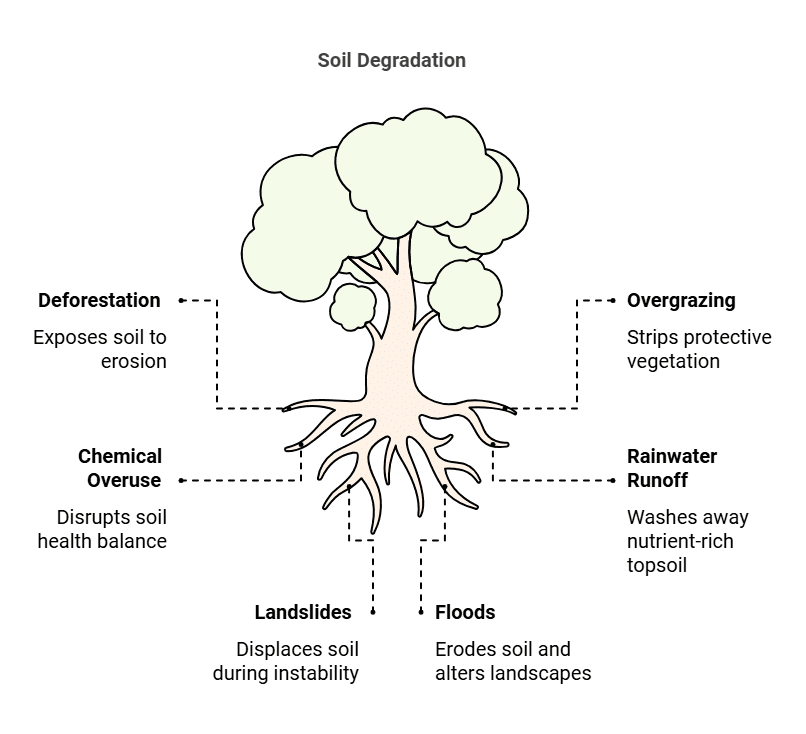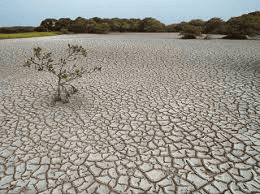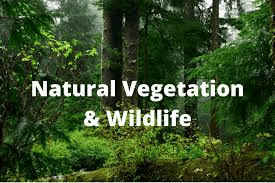NCERT Summary: Land, Soil, Water, Natural Vegetation and Wildlife | Geography for UPSC CSE PDF Download
Land
- Land is a crucial natural resource, constituting about 30% of the Earth's surface.
- However, not all land is suitable for human habitation.
- The global population is unevenly distributed due to differences in land quality and climate.
- Areas with challenging terrain, such as steep mountains and low-lying regions susceptible to flooding, tend to have fewer people.
- Deserts and dense forests are often sparsely populated or uninhabited.
- In contrast, plains and river valleys are ideal for agriculture, leading to higher population densities in these regions.

Land Use
- Land Use refers to the various ways in which land is utilized, including activities such as agriculture, forestry, mining, and the construction of houses, roads, and industries.
- The use of land is influenced by both physical factors—like topography, soil quality, climate, mineral resources, and water availability —and human factors, including population density and technological advancements.
- Land can be categorized based on ownership into:
- Private land, which is owned by individuals.
- Community land, which is owned by the community and used for common purposes such as gathering fodder, fruits, nuts, or medicinal herbs. This type of land is also known as common property resources.
- The availability of land is limited, and its quality can vary significantly from one region to another.
- As the demand for land increases, it puts pressure on common property resources, making them more vulnerable.
- Changes in how land is used often reflect cultural shifts within society, indicating evolving values and practices.
- The expansion of activities such as agriculture and construction poses various environmental risks, including land degradation, landslides, soil erosion, and desertification.
Conservation of Land Resources
- The growing population and its increasing demands have caused significant harm to forests and farmland.
- This has raised concerns about the depletion of these vital natural resources.
- To address the current level of land degradation, which includes soil erosion, deforestation, and desertification, it is essential to take action.
Methods to Protect and Conserve Land Resources
- Afforestation: Involves planting new trees to restore and expand forest areas that have been depleted or damaged.
- Land Reclamation: The process of rehabilitating and restoring previously damaged or degraded land to make it usable and productive again, such as converting wasteland into arable land.
- Regulated Use of Chemical Pesticides and Fertilizers: Refers to the careful and controlled application of chemical pesticides and fertilizers to minimize their negative impact on the environment, soil health, and biodiversity. This includes following recommended guidelines and using organic or less harmful alternatives when possible.
- Checks on Overgrazing: Involves monitoring and controlling livestock grazing practices to prevent overgrazing, which can lead to land degradation, soil erosion, and loss of vegetation. This may include implementing rotational grazing systems and setting grazing limits to protect fragile ecosystems.
Soil
- Soil is a thin layer of grainy material that covers the Earth's surface and is closely related to land.
- The type of soil in an area is determined by the landforms present there.
- Soil is made up of organic matter, minerals, and weathered rocks, which come together through a process called weathering.
- A good balance of minerals and organic matter is necessary for creating fertile soil.
Factors Influencing Soil Formation
- Parent rock and climatic conditions are the main factors influencing soil formation.
- Other important factors include:
- Topography. The shape and features of the land.
- Organic material. The presence of living or decaying plants and animals.
- Time. The duration it takes for soil to develop.
- These factors can vary from one location to another.

Soil Degradation and Conservation Techniques
Soil degradation refers to the decline in soil quality and health due to various factors and human activities. It is a significant environmental concern as it affects agricultural productivity, biodiversity, and ecosystem services. Let's explore the factors leading to soil degradation and the conservation measures to prevent it.
Factors Leading to Soil Degradation

- Deforestation: Cutting down trees exposes the soil to erosion. Trees play a crucial role in protecting the soil by preventing erosion and maintaining soil structure.
- Overgrazing: Excessive grazing by animals can strip away vegetation, leading to soil damage. Vegetation acts as a protective cover for the soil, and its removal makes the soil more vulnerable to erosion.
- Excessive Use of Chemical Fertilizers or Pesticides: Overuse of chemical inputs can harm soil health by disrupting its natural balance. Chemical fertilizers and pesticides can degrade soil quality, affect beneficial microorganisms, and contaminate water sources.
- Rainwater Runoff: Heavy rains can wash away the top layer of soil, leading to erosion. The top layer of soil is rich in nutrients and organic matter, and its loss can severely impact soil fertility.
- Landslides: Soil can be displaced during landslides when slopes become unstable. Landslides occur due to various factors such as heavy rainfall, earthquakes, or human activities, leading to the sudden loss of soil and vegetation.
- Floods: Excess water from floods can erode soil and change landscapes. Floods can wash away significant amounts of soil and alter the landscape, making it unsuitable for agriculture and other uses.
Conservation Measures for Soil
- Afforestation: Planting trees helps restore and maintain soil health by preventing erosion and improving soil structure. Trees provide shade, reduce soil temperature, and enhance soil moisture retention.
- Mulching: Covering bare ground with organic matter like straw helps retain soil moisture and protect the soil from erosion. Mulch acts as a protective layer, reducing evaporation and preventing weed growth.
- Contour Barriers: Building barriers with stones, grass, or soil along the contours of the land helps prevent soil erosion. Contour barriers slow down water runoff and promote water infiltration, reducing soil loss.
- Rock Dams: Piling up rocks to slow down water flow helps prevent gully formation and further soil loss. Rock dams are effective in reducing the speed of water flow, allowing sediment to settle and preventing soil erosion.
- Terrace Farming: Creating broad, flat steps on steep slopes provides flat areas for growing crops, reducing surface runoff and soil erosion. Terracing helps in water conservation and prevents soil loss on steep slopes.
- Intercropping: Growing different crops in alternate rows and at different times helps shield the soil from rainwater runoff. Intercropping enhances biodiversity, improves soil health, and reduces the risk of crop failure.
- Contour Ploughing: Ploughing along the contours of a hill creates natural barriers that slow down water flow, reducing soil erosion. Contour ploughing helps in retaining soil moisture and preventing soil loss on sloped land.
- Shelter Belts: Planting rows of trees in coastal and dry areas reduces wind movement and protects soil cover. Shelter belts act as windbreaks, reducing wind erosion and protecting soil from desiccation in dry areas.
Water

- Water is a vital renewable natural resource, covering three-fourths of the Earth's surface, which is why our planet is often called the "water planet."
- Life on Earth began in the ancient oceans around 3.5 billion years ago. Even today, oceans cover two-thirds of the Earth's surface and are home to a wide variety of plants and animals.
- However, the water in the oceans is saline, meaning it is not suitable for human consumption.
- Freshwater accounts for only about 2.5% of the Earth's total water supply:
- 70% of this freshwater is locked away in ice sheets and glaciers, mainly in Antarctica, Greenland, and mountainous regions, making it difficult to access.
- Only about 0.3% of freshwater is readily available for human use. This accessible water is found as groundwater, surface water in rivers and lakes, and water vapor in the atmosphere.
- Freshwater is the most precious resource on Earth. Its total volume remains constant because it continuously cycles through the water cycle, which includes processes like evaporation, precipitation, and runoff. This ongoing cycle is crucial for sustaining life on our planet.
- Water is essential for various activities, including:
- Drinking
- Washing
- Agriculture
- Industries
- Generating electricity through dam reservoirs
- Several factors are contributing to shortages of freshwater, such as:
- Increasing population
- Growing demands for food and cash crops
- Rising urbanization
- Higher living standards
- Depletion of water sources
- Water pollution
Problems of Water Availability

Water Scarcityis a significant issue in various parts of the world, including:
- Most of Africa.
- West Asia and South Asia.
- Areas in the western USA and north-west Mexico.
- Certain regions of South America.
- The entire continent of Australia.
Countries that are drought-proneface acute water scarcity due to factors such as:
- Fluctuations in seasonal or annual precipitation.
- Over-exploitation of available water resources.
- Contamination of water sources, making them unusable.
Conservation of Water Resources
Access to clean and sufficient water is a critical global concern. While water is a renewable resource, its overuse and pollution render it unsuitable for consumption.
Major causes of water pollution:
- Release of untreated or inadequately treated sewage into water bodies.
- Application of agricultural chemicals that contaminate water sources.
- Discharge of industrial effluents into rivers, lakes, and oceans.
- Introduction of non-biodegradable pollutants such as nitrates, metals, and pesticides into water, which then enter human bodies.
Measures to control water pollution:
- Ensure proper treatment of effluents before their release into water bodies.
- Preserve forest and vegetation cover to reduce surface runoff and enhance groundwater recharge.
Water conservation methods:
- Implement water harvesting techniques to capture and save surface runoff.
- Properly line irrigation canals to minimize water seepage.
- Use sprinkler systems to decrease seepage and evaporation losses during irrigation.
- Adopt drip or trickle irrigation in arid regions to reduce evaporation losses.
- Establish wastewater treatment and water reuse initiatives.
By implementing these methods, we can effectively conserve the precious water resource.
Natural Vegetation and Wildlife
- Students visited a handicrafts fair displaying products from various regions of the country.
- Mona was impressed by a handbag made of jute.
- The teacher highlighted items like baskets, lamp shades, and chairs crafted from cane and bamboo, materials that are plentiful in the humid areas of eastern and northeastern India.
- Jassy spotted a silk scarf.
- The teacher clarified that silk is produced by silkworms that are raised on mulberry trees.
- The children understood that plants offer a wide range of products that are essential for daily life.

Ecosystem
- Natural vegetation and wildlife are part of the biosphere, which includes all ecosystems on Earth.
- An ecosystem is a system that supports life, where all living things depend on each other.
Uses of Vegetation
- Timber. Used for construction and furniture.
- Fruits. Consumed as food.
- Nuts. Eaten as snacks or used in cooking.
- Medicinal plants. Used for making medicines.
- Latex. Used for making rubber products.
- Gum. Used in food and adhesives.
- Turpentine oil. Used in paints and as a solvent.
- Paper. Made from wood pulp and used for writing and printing.
Uses of Wildlife
- Milk. Consumed as food and used in various products.
- Meat. Eaten as food.
- Hides. Used for making leather products.
- Wool. Used for making clothing and blankets.
- Bees. Produce honey, help in pollination, and act as decomposers.
- Birds. Eat insects and help in decomposition.
- Vultures. Clean the environment by eating dead animals.
- Both plants and animals, large and small, are essential for keeping the ecosystem balanced.
Distribution of Natural Vegetation
- The growth of vegetation is primarily dependent on temperature and moisture levels.
- The main types of vegetation found around the globe include:
- Forests: These are situated in regions with heavy rainfall, which supports the growth of large trees.
- Grasslands: Found in areas with moderate rainfall, grasslands are characterised by grasses and some small trees.
- Scrublands: These are located in dry regions with low rainfall. Vegetation in scrublands has deep roots and features thorny, waxy leaves, which help minimise moisture loss through a process called transpiration.
- Tundra: This type of vegetation is found in cold polar regions and consists mainly of mosses and lichens.
- Human activities have led to significant deforestation, impacting various types of vegetation and highlighting the urgent need for conservation efforts.
Conservation of Natural Vegetation and Wildlife
- Forests play a crucial role in the ecosystem by providing habitat for animals and facilitating interactions between plants and animals.
- Habitat loss caused by climate change and human activities poses a severe threat to many plant and animal species, making them vulnerable, endangered, or extinct.
- Factors contributing to extinction include:
- Human-induced factors: Deforestation, soil erosion, urban development, and poaching.
- Natural factors: Forest fires, tsunamis, and landslides.
- Poaching is a significant concern, with animals such as tigers, lions, elephants, deer, blackbucks, crocodiles, rhinoceroses, snow leopards, and peacocks being hunted for their hides, skins, nails, teeth, horns, and feathers.
Conservation Efforts
- Establishing national parks, wildlife sanctuaries, and biosphere reserves.
- Protecting water bodies like creeks, lakes, and wetlands.
- Raising awareness through initiatives such as afforestation and Van Mahotsava.
- Encouraging activities like birdwatching and participation in nature camps to foster an appreciation for biodiversity among students.
- Legal measures. Many countries, including India, have laws prohibiting the trade and killing of certain birds and animals. The Convention on International Trade in Endangered Species (CITES) identifies species protected from trade.
- The conservation of plants and animals is an ethical responsibility shared by all citizens to maintain environmental balance.
|
264 videos|875 docs|232 tests
|
FAQs on NCERT Summary: Land, Soil, Water, Natural Vegetation and Wildlife - Geography for UPSC CSE
| 1. What are the main factors leading to soil degradation? |  |
| 2. What are some effective conservation techniques for soil? |  |
| 3. How does vegetation contribute to the ecosystem? |  |
| 4. What are the uses of wildlife in natural ecosystems? |  |
| 5. What measures can be taken to conserve land resources effectively? |  |

















